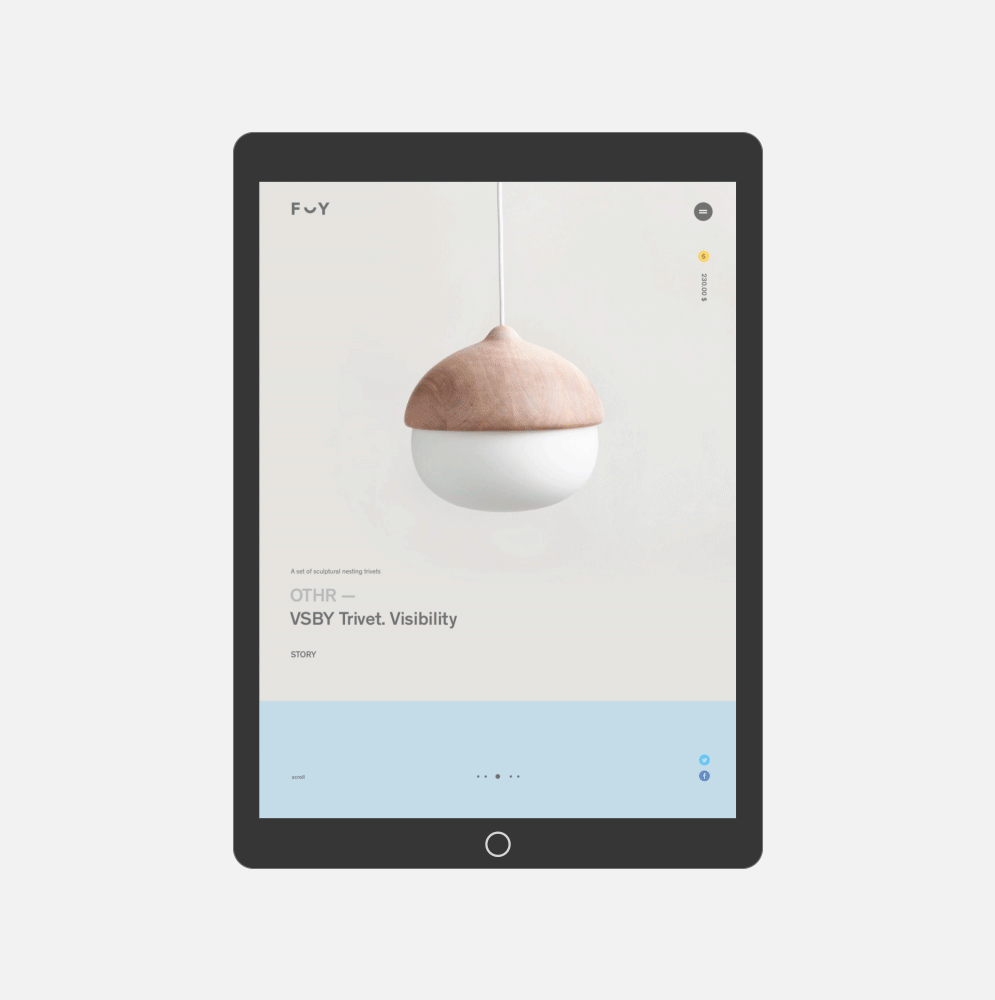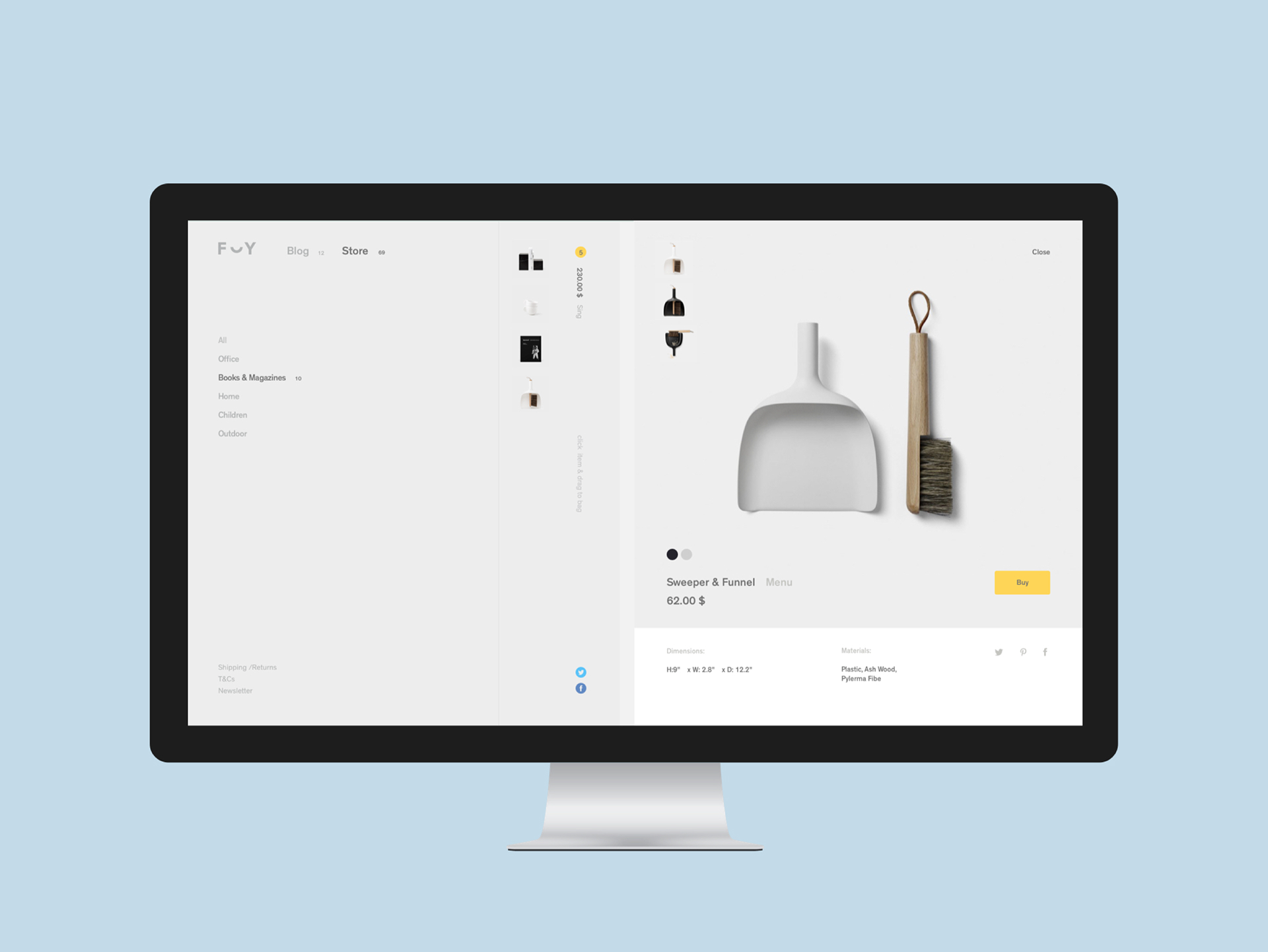May 18, 2017
Interview with Rubber House Founder: Ivan Dixon
Interview with Rubber House Founder: Ivan Dixon
Today we are proud to present this awesome animation studio for you guys, we’re talking about the marvelous “Rubber House”. We had the great opportunity to talk with Ivan Dixon, one the thwo founder of tis factory of dreamlike animations. Rubber House is ascending studio on the animation industry, having already worked with big clients such as Cartoon Network, Nicklodeon and Bethesda Softworks. Check out our interview below:
You can reach Ivan on the following links:
1) First of all I would like to thank you for doing this interview, it’s an honor for us to present more about you to our readers. I would like to start asking you about when your interest for animation began?
I’ve been drawing since as long as I can remember. I distinctly remember my brother and I drawing little dinosaurs all over the walls of our house. Secret ones that only we knew about. Later I drew comics because I wanted to tell stories. I also made primitive computer games and learned to animate as I needed graphics. I had no idea that there could be a career in animation I just wanted to draw and learn how to get better. I looked to the internet to learn more technical animation terms and skills and I went through that obnoxious phase many young animators go through where they look at the real world and start noticing real animation principles in real life, “Look at that drag on that leaf!” / “Check out the secondary on that coat!”
Cartoon Network- Summer Ident (FULL version) from Rubber House on Vimeo.
2) Which movies influenced you the most? Why?
I’d say I was more influenced by television animation. I loved The Simpsons and a lot of the 90s Nickelodeon shows. I like how TV animation is able to explore more understated narratives, weird little side stories or side characters. I saw my first Studio Ghibli film when I was in grade four (Porco Rosso) and it blew me away. Honestly, they make the only animated films that I wholeheartedly adore. Because they don’t pander. They let the stories be rich and complex and the characters multifaceted. Plus the animation, on a technical level, is so beautifully crafted. Every shot in one of their films is a master class in animation.
Adult Swim. Player Hater from Rubber House on Vimeo.
3) You guys at Rubber House are pretty versatile with you projects, but at the same time there’s always a recognizable element in your work. How do you guys approach the creative process on your projects?
The Rubber House house style is essentially Greg Sharp and I trying to meet somewhere in the middle of our own personal styles. I’ll do a sketch, he’ll do a draw over then we arrive at this new place. So a third, new style emerges. The process normally starts with a question, what’s the best way to resolve the brief? We fret over the internal logic of a design quite a bit. Lately we’ve been tasked with adopting different period styles. I like this because it gives us clear boundaries and a framework to critique each other’s creative choices. For example: “could they have done this back then?”
4) The animation industry can be really rough, how do you guys approached big guys like Cartoon Network and Nickelodeon?
They approach us. The only advice I can give on this front is that if you work hard, produce work and put it out there online you’ll get noticed eventually. Something I say to younger animators is this: no one is going to pay you to do something until you’ve already proven you can do it. So make work.
Tonk’s Island from Nickelodeon International on Vimeo.
5) What would you consider the best moment on your career till now? And what you think was the lowest? What lessons you got from that?
My highlight would have to be visiting The Simpsons table read, writers room and pre-prod studio after Paul Robertson and I made our Simpsons Pixels intro. Another highlight was having the Rubber House music videos we did for Gotye screen at the Sydney Opera House. Low point…there were some questionable jobs that we accepted early on that never made it to our site for good reason. Basically service work where we didn’t influence the design or writing in any way. Every day I’m grateful that I get to work for myself. Seeing other more corporate work environments makes me shudder. I like the freedom that comes with running your own creative business.
6) How do you describe your daily routine?
Greg and I actually work in separate offices in separate cities (me in Melbourne, Greg in Sydney). At this point we’re like John and Paul near the end of the Beatles –we can’t stand to be in the same room (jk).
Each day the first thing I do is check my emails. As we work for mostly US clients these days we often have a wave of correspondence arrive over the evening. Then Greg and I get on Skype and discuss how we’re going to distribute the day’s work. If we’re running a larger crew we’ll do our daily approvals (going over shot lists and checking off animation, backgrounds etc). Then we just work all day and check in with each other when required. I try to stick to regular business hours as I think it’s important to have a well rounded life outside of work if you want to make work that resonates with a broader audience (not just other nerdy animators).
Adult Swim. Fab Sauce from Rubber House on Vimeo.
7) Being a multimedia artist, please tell us what’s your favorite media/animation style to work with? Why?
I originally learned to animate in pixel art, so I’ll always have a soft spot for the precise, retro charm of plotting an image dot by dot, however I feel that there’s probably more potential for greater subtlety and beauty in 2D traditional style animation. Like I mentioned earlier, we’ve been emulating a lot of older periods lately (1930’s rubber hose, 1960’s action shows) and it’s been a lot of fun embracing the limitations of those styles. It’s a lot harder approaching a new contemporary style because there’s no rules, other than, “Does it look good?” which can be really subjective.
8) Tell us five websites that you like to visit frequently.
Tumblr
Pornhub
Cartoon Brew
9) Thanks again for your time, please leave a final message for the ones who are starting out on this kind of business
Never stop learning. Be critical. Embrace other opinions but know that it’s okay to reject feedback if you can defend your position. Some clients want (or need) to be educated on the animation process. You’re the expert and they’ll listen if you explain why something is a bad idea, too costly, too time consuming etc. I see a lot of really introverted and shy artists accept unreasonable demands, not complain about it to the people they should be and then burn themselves out.
Thanks for inviting me to be interviewed. Hope my answers were helpful…or at least not boring.
Adult Swim. Triangl’d from Rubber House on Vimeo.
marcos333
May 18, 2017
Source: Abduzeedo Interviews
May 18, 2017
HOW TO BUILD AN AGILE VISUAL CONTENT STRATEGY IN 7 STEPS
This article originally appeared on Column Five.
“We need to be more strategic.”
These might as well be trigger words. What does that phrase really mean? The subtext is often something like:
- “Let’s slow down and not do anything and have several more meetings.”
- “Can one of you put in the hard work to figure out what being strategic actually means, then bring us some proposed frameworks for making a decision so we can scrutinize them from our armchairs?”
Strategy is a good thing, but it can be overwhelming. Where to start? What do you focus on? It always helps to create a shared definition of strategy—and a framework to discuss it—that is simple enough to understand without doing 10 years at a Big 4 consulting firm.
There are many levels of strategy in an organization, both broad and niche. In this post, I’m focusing specifically on visual content marketing strategy, which is an important and growing subset of your overall content strategy.

THE KEY TO A STRONG VISUAL CONTENT STRATEGY
Too often content marketers proceed without a strategy, or with an overly stringent strategy. When things don’t work, they have to go back to square one to reassess the foundation of their strategy. This is painful because it often requires scrapping some good work in progress—work that would be nice to complete but would ultimately distract from the larger prize.
You don’t want to waste work. You can’t afford to either. The right visual content strategy can prevent this. But what makes a good strategy?
Several years ago, Shelly Bowen, Chief Content Strategist at Pybop, articulated the definition of good content strategy to me as “a solid foundation that gives you room to move.”
This is sound thinking to help you be more agile in your content marketing practice. However, agile doesn’t mean “wing it,” just like doing foundational work and articulating a visual content strategy doesn’t mean “set everything in stone.”
We need to marry the two modes of thinking to create the right visual content strategy (aka structure) to guide intelligent experiments. For many, this is difficult.
In his book, Growing Up Fast: How New Agile Practices Can Move Marketing and Innovation Past the Old Business Stalemates, Jascha Kaykas-Wolff identifies the “push and pull” between the desire for stability vs. the need for change as the core challenge of not only content marketing but our entire universe.

The real key to creating a good visual content strategy is balancing complementary opposites. It’s not about planning every action for the rest of your existence but rather putting in place a stronger decision-making framework to make choices for smarter experiments. Doing this well requires some thinking—which we’re here to help with.
THERE IS AN EASIER, LESS PAINFUL WAY TO APPROACH VISUAL CONTENT STRATEGY—WITH THE RIGHT LENS.
After working on thousands of visual content projects with our team at Column Five and Visage over most of the past decade, we’ve identified the essential ingredients of a useful strategy.
The framework outlined here is the result of a lot of complaining, giving up, trying again, questioning our team, then arriving back to square one with a refreshing but bewildering focus, yet again, on what is most essential. (In content and life, we are so often just beginning again.)
This straightforward, step-by-step approach guides you through 7 sprints, which build on each other to form your visual content strategy foundation. Once completed, you can feel confident your content marketing will be on the right track. Ready?

The first step in building your visual content strategy is understanding who you really are and what you’re after—your brand’s true purpose. It sounds intense, but this is crucial.
Repeat after me: “My purpose is not my measurable objective.”
The purpose of your organization is not just to double your business or increase leads by 10%. (We’ll get to that.)
Whether you are the CEO or starting out as a social media intern, your purpose lies in the answer to one very important question: Why does your business exist?
If your organization vanished, what would be lost in the world? If your group achieves what you are building together, how will the world be different?
YES, IDENTIFYING YOUR PURPOSE IS HARD WORK.
The reason it’s hard is because of a little thing called financial reality, which beckons all of us to go back to doing “real” work. (Debbie, don’t spend time on that vision board again, you quack! You need to be doing something real, like increasing landing page conversions by 6.3%.)
We often resist the hard work of defining and strengthening our belief in the “why?” of our organization because it feels like fake work; it doesn’t have a concrete sense of being complete like other work tasks.
But this exercise is important because your purpose works as a generator of creative electricity. It informs your culture, which powers your content creation efforts in other areas. (Download our e-books to learn more about how culture marketing can affect content and how you shape your brand.)
In addition to helping you form a visual content strategy, taking the time to do the ethereal work that you and your colleagues at times might find worthless or ill-guided offers a major reward: You get to wake up in 5 years and reflect on your career without saying, “Well, what the $*#& was the point of all of that?”
Once you start to assess what your purpose is and how it resonates with your team, you will fall into one of three categories:
- Your purpose is well-defined and exciting.
- It doesn’t exist (or it does and isn’t exciting), but you can get everyone on board with defining or redefining it.
- It’s not exciting, and you can’t get stakeholder attention on this—for now. (If you’ve struggled with aligning your content efforts, congratulations, this may be the root of the problem.)
If your team is excited about the core purpose, you’re ready to roll into sprint #2.
If you feel it needs some work, it’s time to have discussions about your core purpose.
If you can’t wrangle executive leadership to make this a priority, or they are happy with it and not changing the articulation anytime soon, you’ll have to work with it in its current state. If this is the case, it helps to ask someone to unpack the original meaning behind the purpose statement so you can find more connection to it.
However, if you are in a position to work with executive leadership, make sure to dedicate enough time to this sprint. This ensures that your purpose is a powerful source to guide your visual content strategy.
To work through this exercise with structure, consider bringing in an outside expert to facilitate the process. (We first worked with Mark Eckhardt of Common a few years ago. It can be easier for an outsider to question the ideas your group considers to be absolute truth.)
Looking ahead, from a content marketing perspective, once you know why your business exists, you’re in a position to answer the next question as it relates to your content: What is the most important story for our brand to tell?
Hopefully, your purpose is about something more than just money. Hopefully, you also care about the people in the market you’re serving. Once you know your “why” and feel good about it as a potent source for what you’re creating, you can move on to your next sprint.

After articulating your purpose in sprint #1, you can save a lot of headaches by taking the time to get on the same page about what your words mean. (Hopefully, you’re not working with a bunch of postmodern armchair linguists, but if you are, just tell them this is arbitrary and meaningless but you might as well agree on the same imaginary stuff because unity is fun.)
There are conflicting definitions of common terms used in strategic discussions, and this causes confusion in daily communication throughout the team.
So, as a focus of this sprint, which can be a quick one, build a brief glossary of important terms that will be used often in your strategic planning so you are all speaking the same language. (While you’re at it, abolish obnoxious acronyms.)
For example, what does “we need to be more strategic” really mean to your team? Or, if you are setting goals and breaking them into measurable milestones, are you now talking about objectives?
Creative debate is most effective when people share the same understanding of what important and common words mean. Agree on where this key information will live and treat the glossary as a living document.
By the end of this sprint, you’ll have made some choices at home base. Now it’s time to go outside of your own walls again.

If you are building a business and creating content that is all about you, it won’t resonate with your audience. You have a new ping-pong table in the office? That’s great! No one else cares (even though your college buddy Ronald pretends he wants to have a beer pong tourney at your office someday).
Who are you creating visual content to please and impress? Your coworkers and friends, or your potential customers? To score more than a few ego-boosting points and move toward driving actual revenue from your visual content, focus on defining the latter.
Let’s say you are growing a company and have a huge overall market for your offering. That’s great, right? Well, yes and no.
If you are defining your market as all people who like to eat food, you are trying to be too many things to too many people.
ORGANIZE YOUR AUDIENCE INTO SMALLER SEGMENTS.
For example, instead of deciding your audience is everyone who likes food, you could start with a focus on people in a specific geographic region who are interested in making a change to their health routine but are too busy to cook.
Narrowing your focus need not be equated with thinking smaller. In the agile mentality, you are thinking about the work that will make the biggest impact right now, while keeping your larger purpose in mind.
Identifying an immediately addressable market segment lets you run the right experiments to give you the info you need to help expand in the future.

When you know who you’re specifically going after, you can create content that speaks directly to them. Getting a core audience of people who love what you do will help you grow and be able to choose other customer segments in the future.

As marketers, we sometimes make the mistake of spending too much time in our own echo chambers, speculating about what people might want. Now that you know who your specific audience segment is, you should be talking to them to find out what they want.
The goal of this sprint is to answer the question: “What are my customers’ jobs to be done?”
Specifically, you’re looking to identify the things your customer needs to do but cannot accomplish.
At this stage, talk to your audience more than your coworkers! Set up calls or in-person meetings to get this info. Think of them as interviews. Build a list of questions that will help you get inside their minds.
You want to elicit this person’s frustrations, pain points, and other issues your product or service may be able to solve for. (Spoiler: Your content is how you will communicate your solutions.)
For example, if you’re a B2B marketer and you have a new lead who is willing to take some time to answer a few questions, you might ask:
- What would it take for you to get promoted at work?
- What is the thing that bothers you the most on the commute home at the end of the day?
- What needs to change to get you to stay at your company?
- What have you tried that hasn’t worked?
- What are you doing that is working really well? Why does it work so well?
- What do you hope to accomplish in the next year?
- What is creatively fulfilling to you?
- What jobs do you fulfill on a daily/weekly/monthly basis?
- What thing is missing on your team that would make life easier?
- What fundamentals are not being handled by your group?
- How does your organization relate to experimenting and trying new things?
- What is the most promising opportunity you’re excited about in the next few months?
These important questions help you understand your individual customers and overall market, allowing you to pinpoint where and how you can provide them support. This empathy with your market is the key to creating a legitimate, true brand. When you produce this type of content, you become viewed as a trusted and helpful resource that people will want to do business with.
As you summarize and share your learnings with your team to generate content topics, communicate the audience feedback (challenges) as user stories. For example:
- As a social media marketer, I need to create visual content that is tailored to each of our priority channels, multiple times per day. Our internal design team is tied up on other initiatives most of the time, so I make my own graphics but don’t know what I’m doing.
- As an online Spanish teacher, I find it difficult to connect with my students because the video chat connection is always breaking up.
- As a freelance writer, I wish I could get into a more steady rhythm with my clients.
The work you do here and in sprint #3 (Identify Your Audience) helps you build detailed customer personas, wherein you distil all the information to create a representative “customer.”
Writing out who they are (including info like age, demographic, and even the types of movies they watch), as well as their pain points, brings these customers to life and informs all your content efforts. To create your personas quickly and easily, check out our guide to building marketing personas in under 60 minutes.

Now that you know who you are reaching and empathizing with them (you do care, right?), it’s time to find out where they are when they aren’t chasing Pokémon. This means identifying which distribution channels will help you reach your audience (and, accordingly, where you should invest your time and money).
Work on a long-term approach to creating value and building trust with your audience through distribution. Here are some key questions to get your discussions rolling:
- Where are you publishing content? Download The Ultimate Guide to Content Distribution e-book to learn more about the benefits of each channel.
- How are you promoting content? Make sure you follow best practices to get the most eyes on your content.
- What do you hope someone will do next after viewing visual content? Focus on crafting a buyer’s journey to turn your content marketing into sales.
- What publishing partnerships have been most fruitful, and what new ones would make a big impact? Everyone wants to be on TechCrunch and thinks they have a story worth publishing there. If you do, great! But you should also look for other strategic ways. What would happen if you instead tripled down on that one content partnership you started last year?
- Which of your existing channels work best for reaching your specific audience? This infographic can help you figure out the best channels.
These are important things to keep in mind from the beginning of content ideation. Every component (subject, format, distribution channel) contributes to your overall success.
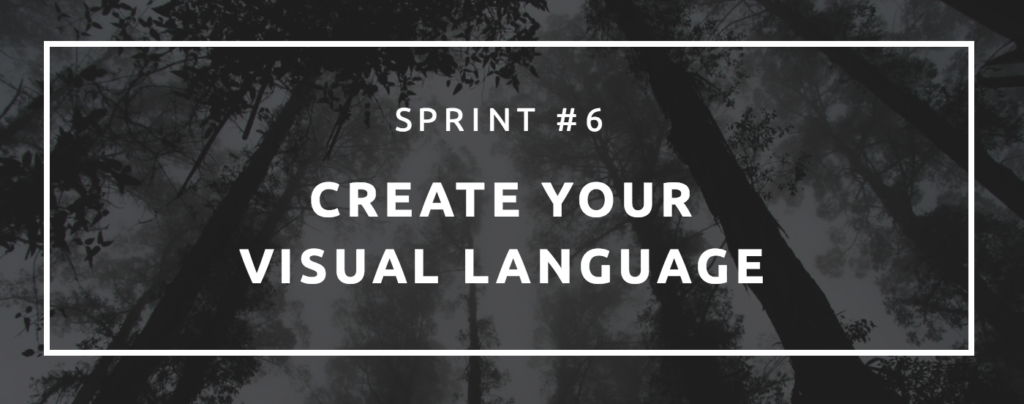
I once asked a brand manager of a Fortune 100 company why brand consistency matters. He said it was simple: to create trust. As such, your content should reflect who you are at the core.
As you dive into designing content down the road, are you going to strictly follow brand guidelines, or is the team free to experiment and push the boundaries of the existing visual identity? Do you know where the brand guidelines are located, including source files and high-res versions of all elements?
There may be cases where you want to take an opportunity to get wild and weird and break the mold. This might be in the context of partnering with another brand to create a visual content experience where you don’t want either brand identity to dominate, such as this collaboration between Column Five and Sharethrough.
Regardless of the approach, it is important to identify how your visual language will be reflected in your visual content strategy. Column Five’s Creative Director, Nate Butler, suggests including these elements:
Voice
- Clear, well-defined messages in every piece of content
- A defined, distinct brand voice
- Consistent overarching messaging
Visual Language
- A cohesive brand identity (logo, color, iconography, fonts, imagery, etc.)
- A flexible, thoughtful, and scalable design system
- Clear visual hierarchy (balance and visual harmony, including grid use and whitespace)
The right answer and approach is subjective for each brand, but there is one rule that is sure to save time and money: Communicate the approach you’re going to take upfront.
This will save back and forth with designers and agency partners down the road. Make sure to get the perspective of all key stakeholders on this topic, so you don’t have someone ambush a project with a ton of edits right before publishing.

Over the course of the last six sprints, your team has put a strong foundation in place that gives you both flexibility and focus for starting your visual content experiments. Now it’s time to brainstorm and start your first content sprint.
A warning when it comes to ideation: Steer clear of “it would be cool if…” type ideas.
When you meet for ideas, everyone should bring real-world, plain language context and application of the idea in the form of user stories. They should also be prepared to tie them to your customer personas (including identifying the pain point the idea addresses).
According to Kaykas-Wolff, a good story (aka piece of content) in the context of agile marketing:
- Is told from a true user’s perspective or experience: addresses a relevant issue for them.
- Explains how value can be created for the customer: positions brand as an expert resource or help.
- Has business impact: helps further your brand goals.
- Is as specific as possible: speaks to the target audience specifically in their language.
- Is scaled for the smallest chunk ofvalue: provides some sort of value, no matter form.
When you have your ideas, designate an owner (or Scrum Master) for the ongoing content sprints the same way an agile software product team has a Product Owner. This is key to bringing agile methodology into your visual content marketing; it also brings clarity to who is responsible for preparing for and leading the planning meetings.
As Kaykas-Wolff explains, “During the Sprint itself, individual as well as organizational goals are agreed on, and are followed using the agile methods that enable listening and acting fast. Agile marketing processes include daily scrums, sprint planning, a task board, a plan of workflow, retrospective analysis, and improvement.”
In short: Plan, complete, measure, tweak. Rinse and repeat. That’s how you tackle visual content marketing.
LOOKING AHEAD
Now that you’ve decided why you’re going to start this journey into creating high-quality visual content, all of your problems are over—except for the fact that you’ll face new competitive threats, egos will flare, someone will hate this entire idea, and another person will only come to half the meetings and sabotage the whole effort. (The modern workplace is fun, isn’t it?)
Remember at all times: This is possible but not easy.
It’s important to provide your team the right support structure to design experiments with testable hypotheses, not to pressure yourselves to come up with the perfect, permanent plan.
On that note, learning how to work with these 4 types of creative thinkers will help you get the most from your team. In addition to understanding each person’s strengths in creative processing, you must also establish the time horizon for consideration and the desired level of detail for the plan.
When things get murky, go back to sprint #1 and see how things are going, in order, in each area. This will help you make sure you’re staying the course.
Want to learn more? Find out why visual content helps your brand and how embracing good design can give your company a competitive edge.
Source: Visual News
May 18, 2017
Premiere Pro Tutorial: Understanding the Workspace
What you’ll learn in this Premiere Pro Tutorial:<p>Understanding the Premiere Pro workspace<p>This tutorial provides you with a foundation for working with …
Source: CW’s Flipboard Feed
May 17, 2017
The Female Lens: Creating Change Beyond the Bubble [Video]
“I don’t want to play a woman who is actually a man in disguise. I don’t want to do comedy that is for women but it’s just women making fun of their bodies, so that men feel more comfortable with how their bodies are different than the way mens bodies’ work. And I don’t want to play the quirky best friend because, I have a different face than a person with a small nose or something. There is this weird thing I think when men write women where they make them be cruel to show that their tough and that is just a real misunderstanding. And I think if you can’t write a woman correctly, then you should not,” said SXSW Featured Speaker, Jenny Slate .
In post-election America, we all want to go “beyond the bubble”—to reach audiences and change minds outside of NYC screening rooms or film-festival panels. Film is uniquely positioned to do just that, and female directors, writers, and actors are using their work to change the perception of women onscreen and off in real world ways. Glamour brought together four female creators to talk about how films do (and don’t) alter perceptions of women across America. Part of Glamour’s “Powered by Women” initiative, this conversation is a don’t-miss for anyone who cares about changing the world.
Indulge in this SXSW 2017 Featured Session with powerhouse women, Janicza Bravo (SXSW 2017 Film, Lemon), Danielle Macdonald (SXSW 2017 Film, Patti Cake$), Gabourey Sidibe, and Jenny Slate. Moderated by Cindi Leive.
Cindi Leive is the editor-in-chief of Glamour magazine and Glamour.com, which together reach one out of every eight American women, with 10 million print readers and 15 million unique users online. Under her stewardship, the magazine has launched a monthly digital edition, popular special editions, apps, and books—including two New York Times best-sellers; Lipstick.com, Glamour’s stand-alone beauty site and Condé Nast’s first-ever digital spin-off; a digital video network featuring original programming inspired by Glamour in partnership with Condé Nast Entertainment; and The Girl Project, a global philanthropic initiative.
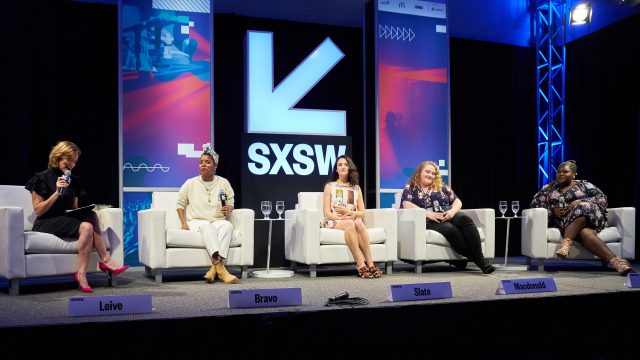
Explore More Content From SXSW 2017
Get inspired by a multitude of diverse visionaries at SXSW – browse more 2017 Keynotes, Featured Sessions, Red Carpets, and Q&A’s on our YouTube Channel.
Follow us on Facebook, Twitter, Instagram, and SXSW News for the latest SXSW coverage, recaps, late-breaking announcements, and updates.
Photo by Ron Herrman
The post The Female Lens: Creating Change Beyond the Bubble [Video] appeared first on SXSW.
Source: SxSW Film
May 17, 2017
Gun Control: What Experts And Americans Agree On
Lately, there has been a lot of talk in the U.S. about gun control. Citizens and politicians find themselves on both sounds of the debate about whether more stringent laws would affect gun-related violence. The intense discussion stems from the increase in gun-related deaths and mass shootings that have occurred throughout the U.S. in the past decade. These discussions are undoubtedly accompanied by a long list of gun control ideas. The Upshot takes a look at 29 leading ideas to determine which solution the public and experts most agree upon.
The Upshot asked experts over at Morning Consult, a media and polling firm, to survey gun violence experts—lawyers, public health officials, and social scientists—on 29 different policies and their effectiveness at lowering gun-related homicides and looked at how the results compared to the policies popularity ratings among American citizens. The policies were then charted with popular, more effective approaches in the upper right corner and less popular, less effective measures in the lower left.

According to the experts, the most effective policies was one that requires gun sellers to run background checks on all potential buyers and another that prevented gun sales to anyone convicted of violent misdemeanors. On the other hand, experts were least drawn to the idea of states honoring out-of-state concealed weapon permits.
Although there is a clear separation in views over gun control and gun rights among Americans, the distinct measures put forward have been generally popular. In the survey conducted, policies like comprehensive background checks and preventing convicted stalkers from obtaining guns were backed by over 85 percent of registered voters. Even the least popular policy was approved of by almost 50 percent.
“We think of guns being an incredibly controversial topic, but what your polling shows and our has shown is there’s a whole lot of gun policies that really aren’t controversial,” said professor and director of Johns Hopkins center for gun policy and research Daniel Webster.
However, just because the public supports a policy doesn’t mean it will become legislation. Donald Trump, along with the Republican Congress, has done little to move measures forward that would rein in gun ownership.
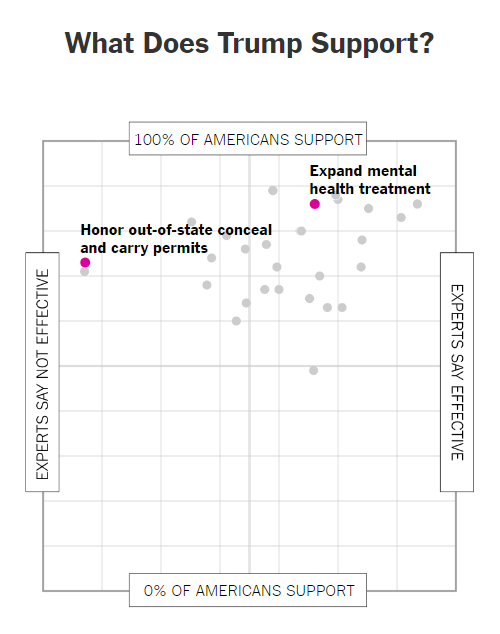
Prior to his campaign, Trump indicated that he supported a few of the more favored measures. It wasn’t until he entered the presidential race that he began to come out in strong opposition to limiting gun rights for Americans. Since his election, Trump has backed interstate concealed carry permits and supports a lift on gun restrictions in schools and military bases.
The bill that requires states to honor out-of-state concealed carry permits ranks as one of the worst performing ideas on the matrix created by Upshot. Although many of the experts surveyed said they did not believe the bill would be capable of reducing firearm homicides, a bulk of Americans still supports it.
Trump, in fairness, also proposed more treatment for those with a mental illness, an idea that ranked better among the public and experts alike.

The survey also covered policy effectiveness in regards to mass shootings, incidents which make up roughly 1 percent of firearm-related homicide deaths. Many of the preferred measures stayed about the same, but bans on assault weapons and large-capacity magazines or restrictions on ammunition purchases were determined to have more of an effect on mass shootings than everyday gun violence. Although experts acknowledged that those policies wouldn’t scale down the number of mass shootings, the new limitations and restrictions may be able to reduce the number of lives taken in those circumstances.

Of the panel of experts questioned for the survey, a majority favored gun control policies while only five said they were in adverse to them. With that said, the five experts that oppose gun control were more likely to rate ideas as less effective compared to their colleagues. But some policies, like expanded screening, treatment of mental illness, and restrictions on gun sales to people who have been convicted of stalking, were still considered effective in reducing gun homicides.
In general, the experts that were more reluctant towards gun control policies were just broadly opposed to blanket policies. “The essence of a ban is it applies to everyone equally, at least theoretically,” said emeritus professor of criminology and criminal justice at Florida State University Gary Kleck. “But in practice, criminals, being criminals, don’t obey the law.”
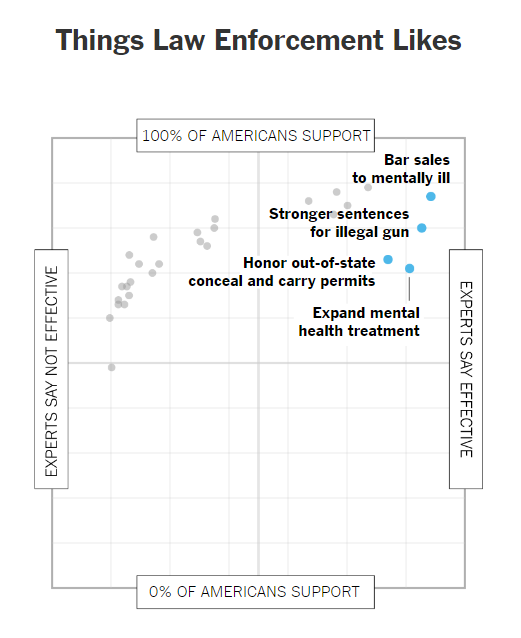
The survey also included two law enforcement groups. The responses, which came from almost 100 police officers and chiefs, were not combined with the responses from the academic experts but looked at separately as a representation of only a small percentage of the law enforcement community.
The responses from the law enforcement professionals revealed that, compared to academic experts, many support policies that advocate civilian use of firearms for defense against crime. On the opposite end, law enforcement was leerier of policies that would ban certain firearms or restrict individuals from carrying guns than academics.
Because the survey combines the two groups of law enforcement to determine policy approval, it is hard to determine what the differences may be like between them. While research has shown that police chiefs are more likely to back measures that restrict access to firearms, police officers tend to gravitate towards gun rights.

Read more about other aspects of their study not included in the surveys or charts here.
[Via: The New York Times]
Source: Visual News
May 17, 2017
Explore the World with Drone Photography
Explore the World with Drone Photography
Photography with drones is something I can’t wait to pursue through experimentations and of course travelling eventually. It’s always been about reaching another perspective on how we see things around us. Let’s explore some parts of the world with Henry Do who is a travel photographer that takes pretty beautiful shots with his drone. Let’s follow his journey from the islands of Hawaii to a dense forest of Portland.
Behind this series is the work of Henry Do who is working as a travel photographer currently based in Las Vegas, Nevada. You wouldn’t want to travel as a job? (Raise your hand!) You should definitely follow his travelings on Instagram.
Via Instagram @henry_do
More Links
- Follow Henry on Instagram
- Check out Henry’s personal site at henrydo.com
- Take a look at his prints from Society6
AoiroStudio
May 17, 2017
Source: Abduzeedo Photography
May 16, 2017
HOW TO MAKE GREAT CONTENT FOR YOUR BUYER’S JOURNEY
This article originally appeared on Column Five.
What’s the biggest mistake I see content marketers make? They spend too much time talking about themselves instead of learning about what their potential customer needs. They forget that you can’t sell a solution until you know the problem. And even then, as a marketer, you shouldn’t be selling anything.
To put it bluntly: Too many marketers are making a case for their company prematurely in the buyer’s journey.

To avoid this, make sure you know the difference between marketing and sales.
SALES ACTIVITIES VS. MARKETING ACTIVITIES
Marketing is when you address your clients’ problems, then make a case for solutions.
Sales is when you talk about yourself as the best solution.
Marketing’s job is to ease people into the sales stage of the relationship, creating the best possible experience along the way so that people are excited to buy.
For this reason, marketers should focus on talking about their clients’ problems and offering solutions. Not only does this lead to more excited and engaged customers, it helps your sales process and team as well.
So how do you create content to engage your audience at different stages? When should you talk about your company and what it has to offer? When do you pass it off to your sales team?
Welcome to the buyer’s journey.
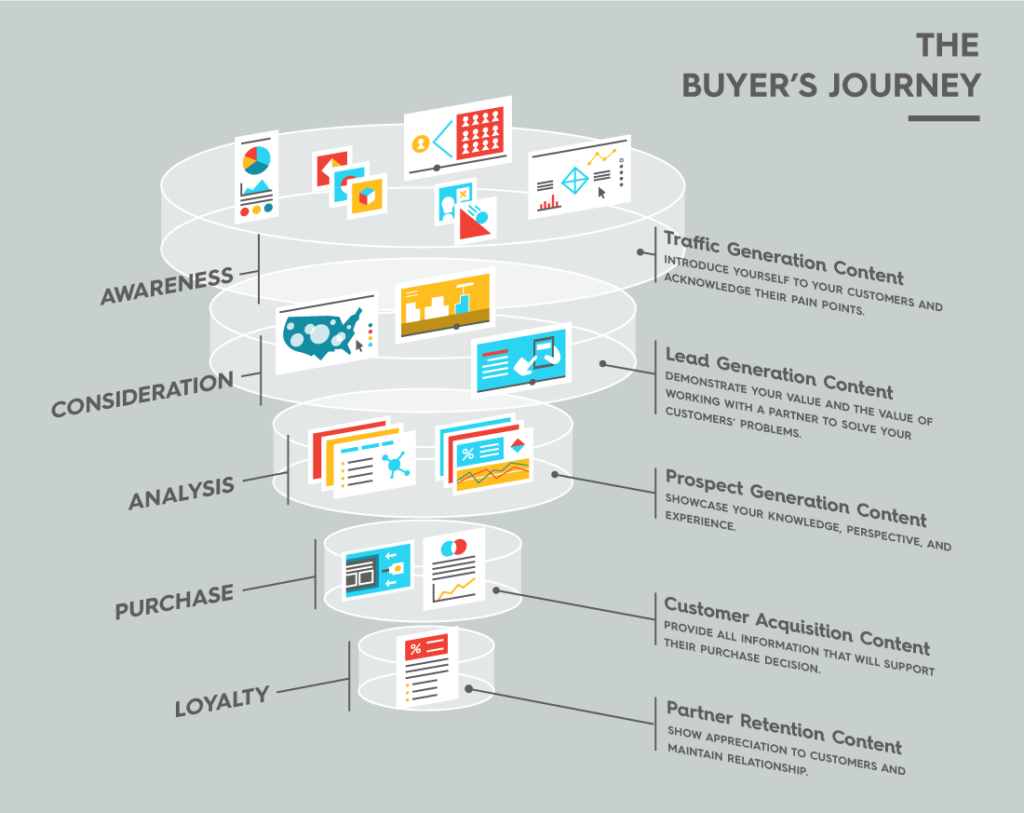
MAPPING YOUR CONTENT TO THE BUYER’S JOURNEY
The buyer’s journey has five distinct stages:
- Stage 1: Awareness
- Stage 2: Consideration
- Stage 3: Analysis
- Stage 4: Purchase
- Stage 5: Loyalty
The best thing about this approach is that these stages integrate both marketing and sales:
- Stages 1, 2, and 3 = Marketing
- Stages 4 and 5 = Sales
Even better, it allows you to create different types of content to match each specific stage of the Buyer’s Journey.
This is the basic framework we use at Column Five to strategize content for ourselves and our clients.

The goal: Introduce yourself to your customers and acknowledge your target customers’ pain points or issues they’re struggling with.
The buyer’s mindset: They want, need, or have an undefined yearning for something. This is your opportunity to articulate what that might be, to produce content that resonates with them so they begin to think about exactly what it is they want or need.
Content messaging: Focus on content that helps as many people as possible get to know you. Sometimes this requires piggybacking on other people’s audiences.
- Articles
- Blog posts
- Partnership content + collaborations
- Features
- PR collateral
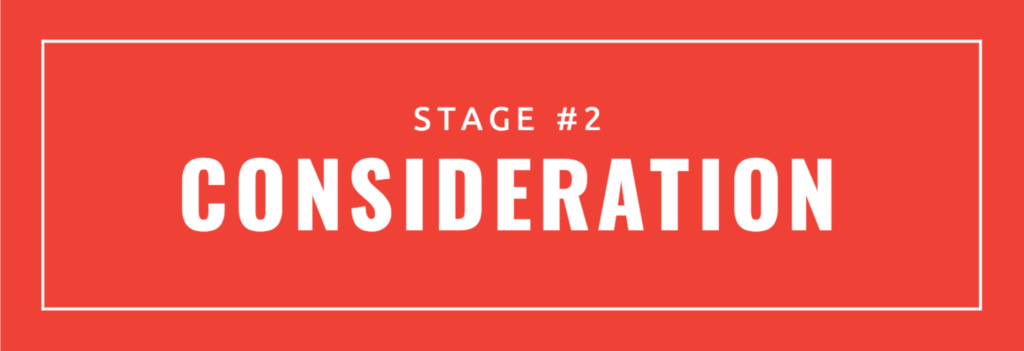
The goal: Demonstrate your value and the value of working with a partner to solve your customers’ problems.
The buyer’s mindset: They now have a clearer understanding of what they want or need and are looking for people to help satisfy this desire, whether it’s a product, service, etc. They are in the early stages of research, looking to get the lay of the land. They want to see who the players are and who they could (and should) be giving their business to.
Content messaging: Showcase your familiarity with the problems your clients are trying to solve. Publish thought-leadership that showcases your perspective and experience in addressing these problems.

The goal: Give people the info they need to make an informed decision about working with a company in your space.
The buyer’s mindset: This is the stage where most buyers have whittled their options down to a handful of choices. Now they start comparing unique value propositions.
Content messaging: Produce thought-leadership that showcases that you are the definitive leader in the space by demonstrating your successes or legitimacy.
- Case studies (when applicable)
- Client testimonials
- High-profile or industry-leading endorsements

The goal: Turn prospects into customers.
The buyer’s mindset: This is the point at which pricing, purchase details, and post-buying experiences are scrutinized. Would-be buyers start asking themselves questions about the transaction: What will it mean to become a customer (read: “a supporter”) of this business? Am I sure I want to go through with this?
Content messaging: Provide information that will support their purchase decision.
- Sales collateral
- Webinars

The goal: Nurture and maintain the relationship.
The buyer’s mindset: They want to be reminded of why they are working with you or supporting your business. They want to feel and believe their relationship is not just transactional and that you care about them beyond their conversion into customers.
Content messaging: Deliver content that reminds them why they might want to work with you again—or why they started working with you in the first place.
- Gifts
- “Thank you” content
- Offers for deals
- Exclusive content
- Partnership opportunities
- Events
- Co-marketing opportunities
- Exclusive access (depending on your business)
- Additional and ongoing education in the form of webinars and newsletters
FOCUS ON THE RIGHT MESSAGE AT THE RIGHT TIME
If you come on too strong from the start, your customers may perceive it as a red flag. Instead, work around a sustainable strategy. Marketing is an art, not a one-size-fits all prescription. Take the time to understand your audience, form a relationship, and convert them over time.
Remember that they’re humans. Be sympathetic and tactful, and you’ll build an authentic base of supporters.
For more tips on marketing, learn about the strategy we used to increase our leads 78% in 6 months, find out what 7 traits will make you a better marketer, and learn how to create content that provides true value to your audience.
Source: Visual News
May 16, 2017
Beautify Photography of 100-Year-Old Houses in Budapest
Beautify Photography of 100-Year-Old Houses in Budapest
Photography is all about capturing moments or subjects. It sounds easy but there’s a massive difference between taking a photo and capturing the mood of the scene, or really driving the attention of the spectator to a particular part of the image that makes them think and interpret that scenery in different ways. Hlinka Zsolt has been sharing some beautiful photography collections on his website and the 100-Year-Old Houses is another series of stunning images.
The dominant element of my work is symmetry and the city, specifically Budapest. In my newest series, in the second edition of The 100-Year-Old Houses, I would like to present the beautiful form and forgotten treasures of the capital city architecture by depriving them of their original functions, unfolding them into compositions and focusing on the relationships of their seperate elements.
Hlinka also adds that the design of Budapest’s architecture is a major element of his work, and he has already covered this topic in several series. The special thing about this latest series is that it was taken at the place – on the Belgrade quay – where he took the Urban Symmetry series photos, which have won several international awards. “This time, however, I focused on interior spaces instead of facades and wanted to introduce my beloved buildings in a more intimate tone.” says Hlinka.
Photography
abduzeedo
May 16, 2017
Source: Abduzeedo Photography
May 15, 2017
Race, Gender & Paying For College: Who Bears The Burden Of Student Debt?
This article originally appeared on Priceonomics.
Your college years may be the best ones of your life, but they can also be the most expensive.
Many of today’s students are financing their education with loans, and are graduating with more debt than ever. In fact, the student debt in the US is estimated at $1.4 trillion, more than what Americans owe on credit cards or cars. Saddled with loans, college graduates are having trouble saving for retirement, starting businesses, and even keeping up with daily expenses.
We wanted to know just how much hindrance student debt is causing today’s graduates, and which groups are affected the most. And does student debt have a differential impact by gender or race?
To answer these questions, we analyzed data from Priceonomics customer LendEDU, who surveyed over 1,400 college graduates between the ages of 25 and 54 to learn more, we found that on average, people graduate college with nearly $40,000 in debt and that men have more debt than women. We also discovered that white and asian college graduates have more debt than their black and hispanic/latino peers.
When it comes to financing their education, men tend to get more help from the parents in paying for college than women do. And, among all the demographic groups we survey, Asian students get the most financial help from their parents in paying for college by far. However, Asians are more likely to feel the pressure of student debt preventing them from starting businesses compared to their peers.
***
We first wanted to see how much debt on average afflicted a college graduate. We started off by examining the average student loan debt upon graduation as well as the survey respondents’ average current loan balance.

On average, survey respondents graduated with nearly $40,000 in debt and still have about $30,000 left to pay off of the loan. This means that even years later (since all of our respondents were at least 3 years out of school) college graduates still have an average of 75% of their loans left to pay.
We then wondered if the average student loan debt varied by race or gender. We divided the population by gender as well as into 4 racial categories (white, black, hispanic/latino, and asian) based on how the survey participants self identified.

There is a wide range of average debt upon graduation between the genders and races. White college students have the biggest discrepancy between male and female graduates. On average, white male students graduate with about 33% more debt than their white female peers. Interestingly, white males graduate with the most debt of any of our subgroups, and white females graduate with the second least amount of debt. As a whole, females tended to graduate with less debt than their male counterparts, except for black females who had $272 more in debt than black males. Asian males graduated with the second most debt, just $253 on average less than white males. On the other side, hispanic/latino women graduated with the least amount of debt; they have $564 less to pay off than white women.
In today’s era with skyrocketing college costs, many people receive financial help from their parents. We wanted to know how much assistance our survey respondents received.

Nearly half of the college graduates we surveyed paid for college without any assistance. Only about 10% received about half their tuition from their family. Fewer than one in ten people had the majority of their college finances supported by their parents.
We next wondered how much this financial assistance varied by gender. Since the average amount of debt was smaller for women, was this because they were getting more financial help?

Overall, females receive less help paying for college than their male peers.
Only 6% of women responded indicating that their parents paid for the majority of the tuition, and 50% received no help at all. On the other hand, only 43% of male respondents said their parents did not contribute financially to their schooling. Additionally, one in ten male respondents said their parents paid the majority of their college tuition, nearly double the number of women who answered the same way. This is particularly noteworthy after we saw above on a whole women graduate with less debt than men. So even though they get less financial help from their families, women still have fewer loans to repay after college.
We were then curious to see if familial financial assistance for college varied by race. Again we broke the survey respondents into the same four racial categories based on how they self identified.

Just as we saw when we examined the question by gender, there is a large difference in family tuition assistance when we break the responses down by race. About half as many asians as whites, blacks, or hispanics/latinos said they received no money from their parents towards college.
The most clear finding, however, is that Asians get the most financial help from their parents paying for school. Nearly double the number of asian respondents reported getting the majority of their college tuition paid for by their parents compared to the other races.
Finally, we wanted to explore how student debt affected people in the years after graduation. Did our respondents feel hindered in any way by their outstanding loans and did this sentiment vary by gender?

On the whole, more than half of the respondents of both genders felt that their debt negatively impacted their current lives. Nearly two thirds of respondents said their current loans have made it harder to save for retirement, and over 50% said that the debt has made starting a small business more difficult.
The place where we see the biggest difference in these feelings by gender is in the respondent’s’ feelings about keeping up with daily expenses. Only about half the men said that their debt has made day-to-day finances more burdensome, but 10% more females felt the same way.
Again, we wanted to examine this angle from a racial demographic standpoint. We know that each race graduates with differing levels of debt, but do they also feel unequally burdened by it?

White respondents, more than the other races, felt the most strongly that their student debt hindered their ability to save for retirement and keep up with daily expenses. For example, 13% more white college graduates than asian graduates think their loans have negatively impacted their retirement savings. However, asian respondents feel the most burdened by their debt when it comes to their ability to create their own company. Almost 10% more asian graduates than any other race felt their loans hindered their ability to start a small business.
***
With an average student graduating with $39,165 in debt, all students across the US are feeling the pain of financing their education. But not all groups are burdened equally. We saw that women tend to have less debt than men, despite getting less financial help from their parents. Additionally, white men and asian men graduate with the largest loans, whereas white women and hispanic/latino women have the least. Finally, women disproportionately feel that their debt makes it difficult to keep up with daily expenses, and asians have the most trouble starting small businesses in the face of their loans.
Source: Visual News
May 15, 2017
Website Design & UX: Formerly Yes Store Concept
Website Design & UX: Formerly Yes Store Concept
Happy Monday guys! Let’s start it off with a web design & UX project of a store concept named: Formerly Yes. The thinking behind this concept would be both quite aesthetic and easy to use. Indeed, going through the project; the UI is indeed quite minimal accompanied with simple interactions. Lots and lots of negative space so you eyes are focusing on the products nor anything else. Designed by Milk Work where we have featured before with his work on Fran Silvestre Arquitectos.
Behind this stunning work, we have Milk Work also known as Sergei Gurov. He’s a senior designer and art director based in San Francisco, USA. He really has a distinct style into this web/ui work, you should definitely follow his work on Behance.
AoiroStudio
May 15, 2017
Source: Abduzeedo UI/UX
















